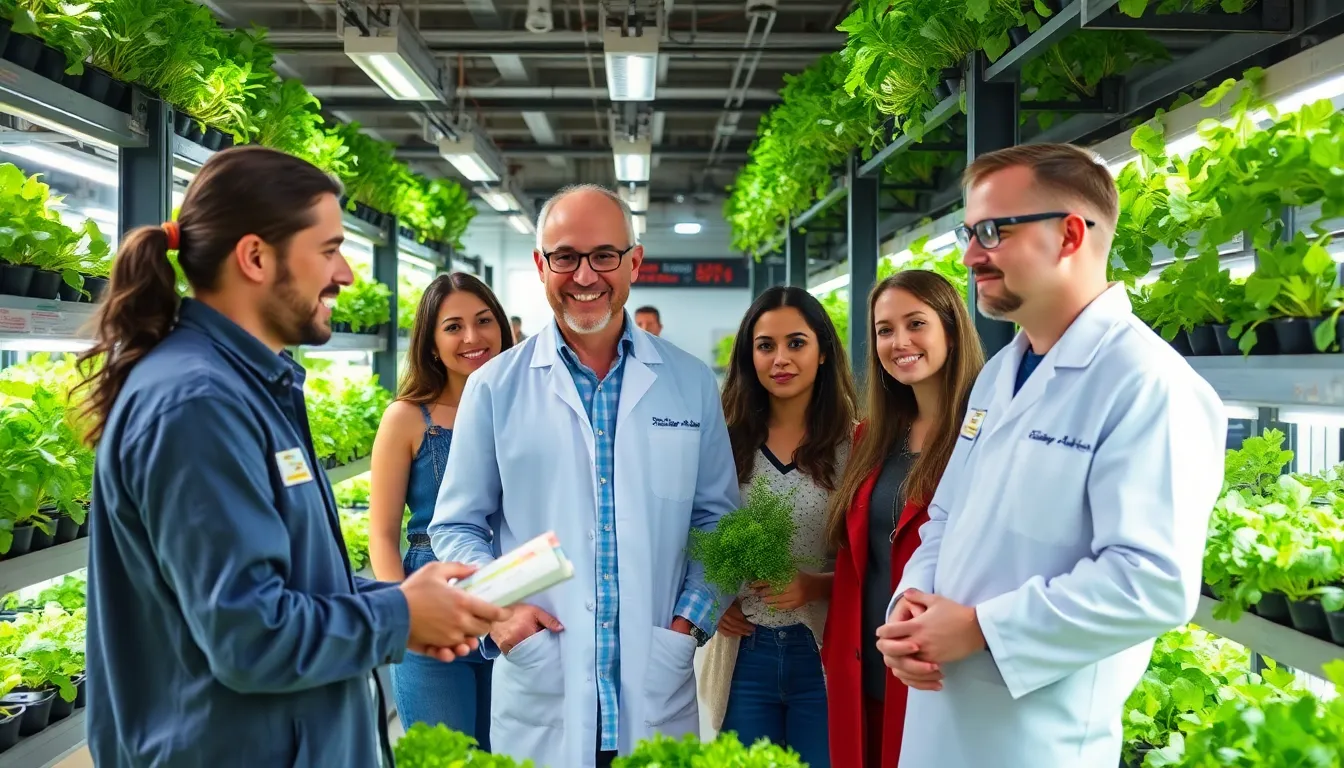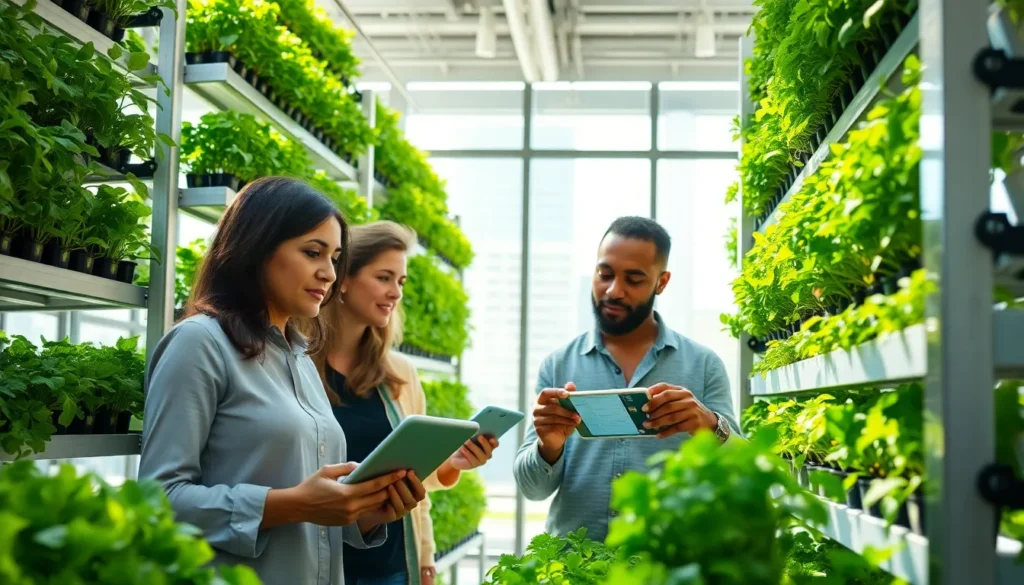Table of Contents
ToggleIn a world where food waste is as common as that one sock that disappears in the laundry, sustainable food technology is stepping in like a superhero with a cape made of kale. This innovative field isn’t just about saving the planet; it’s about making our meals smarter, tastier, and a whole lot greener. Imagine a future where your burger is grown in a lab and your salad is cultivated with the help of robots. Sounds like science fiction, right? Well, it’s happening now.
Overview of Sustainable Food Technology
Sustainable food technology focuses on developing systems that reduce food waste and minimize environmental impact. Innovations in this area include lab-grown meat, which provides a more humane and environmentally friendly alternative to traditional farming. Advances in precision agriculture enhance crop yields with less water and fewer chemicals, directly addressing sustainability concerns.
Smart packaging is another key innovation. This technology can indicate food spoilage, thereby reducing waste at the consumer level. Localized food production systems, such as vertical farms, utilize limited space efficiently, ensuring fresh produce reaches urban areas quickly.
Robot-assisted food preparation is becoming commonplace. These robots not only enhance efficiency but can also help reduce food waste by using precise measurements during cooking. Innovations in fermentation technology allow for sustainable methods of food preservation and nutrient enhancement.
Many companies are exploring food byproducts. Specifically, they transform waste from one process into valuable ingredients for another, fully utilizing resources. Blockchain technology plays a vital role in food traceability, ensuring consumers have access to information about the origin and safety of their food.
Education is critical in this field. By increasing awareness around sustainable food practices, consumers can make more informed choices. Emphasizing knowledge in schools and through community programs bolsters this understanding.
Overall, sustainable food technology represents an essential shift in how society approaches food consumption. Its multifaceted advancements promise not just improved meals but also a healthier planet, showcasing an innovative response to a critical challenge.
Benefits of Sustainable Food Technology

Sustainable food technology offers significant advantages that impact various sectors. These benefits range from environmental improvements to economic gains.
Environmental Impact
Innovations in sustainable food technology greatly reduce environmental harm. Lab-grown meat decreases reliance on traditional livestock farming, lowering greenhouse gas emissions. Precision agriculture maximizes resource efficiency, using less water and fewer chemicals, promoting healthier ecosystems. Intelligent packaging minimizes food waste by alerting consumers when food is spoiled. Urban areas benefit from localized food production, such as vertical farms, that lower transportation emissions while providing fresh produce. Renewable energy sources power many of these technologies, further reducing the carbon footprint associated with food production.
Economic Advantages
Sustainable food technology presents considerable economic benefits. It lowers production costs by increasing efficiency and resource optimization. Farmers experience higher yields and reduced input costs through precision agriculture. Additionally, food innovation creates new job opportunities in sectors like lab-grown meat production and smart packaging. Companies can capitalize on consumer demand for eco-friendly products, enhancing brand loyalty and market share. Transforming waste into valuable byproducts also contributes to new revenue streams. Overall, sustainable practices not only support the environment but also enhance profitability in the food industry.
Innovative Techniques in Sustainable Food Technology
Sustainable food technology leverages innovative practices to improve the efficiency and sustainability of food production. Two prominent techniques, vertical farming and lab-grown meat, exemplify this approach.
Vertical Farming
Vertical farming maximizes land use by growing crops in stacked layers, often within controlled indoor environments. This method addresses space limitations in urban areas and reduces transportation emissions by bringing food production closer to consumers. Using advanced hydroponic and aeroponic systems, vertical farms use up to 95% less water compared to traditional farming methods. By employing LED lighting and climate control, producers can optimize crop growth year-round. Reports indicate that these farms yield several times more produce per square foot, demonstrating substantial potential in providing local, fresh food while minimizing environmental impact.
Lab-Grown Meat
Lab-grown meat represents a breakthrough in sustainable food technology, offering an alternative to conventional livestock farming. This process involves culturing animal cells to produce meat without raising and slaughtering animals, significantly reducing greenhouse gas emissions. Studies show that lab-grown meat can use up to 99% less land and water compared to traditional meat production. Many start-ups are actively working to make cultured meat more affordable for consumers, with some products already available in select markets. With increasing consumer interest and regulatory support, lab-grown meat stands as a viable solution to address food security and animal welfare concerns in a rapidly changing world.
Challenges Facing Sustainable Food Technology
Sustainable food technology faces several challenges that hinder its widespread adoption. Technological barriers impact development and implementation, while consumer acceptance plays a vital role in the success of innovative solutions.
Technological Barriers
Development of sustainable food technologies encounters significant technological barriers. Limited access to advanced research and development restricts innovation. High costs associated with lab-grown meat and automation technologies also deter investment. Engineers often face difficulties in scaling production processes to meet demand. Moreover, regulatory hurdles can slow down the approval of new technologies. All these factors can stall progress and slow the transition to sustainable solutions in food production.
Consumer Acceptance
Consumer acceptance significantly impacts the success of sustainable food technologies. Many individuals remain wary of lab-grown meat and perceive it as unnatural. Concerns about taste, texture, and safety contribute to hesitance. Knowledge gaps exist, as consumers may not fully understand the benefits of sustainable options. Furthermore, price sensitivity can influence purchasing decisions, with initial costs often higher than traditional products. Education and marketing strategies play essential roles in shifting public perception and fostering acceptance. As awareness grows, consumers may embrace these advancements, ultimately driving demand for sustainable food technologies.
Future Trends in Sustainable Food Technology
Sustainable food technology continues evolving, driven by innovations that promise environmental and economic benefits. Trends point toward enhanced efficiency and consumer acceptance.
Advances in Research
Research institutions are exploring new methods for improving food production sustainability. Scientists focus on breeding crops with higher resilience to climate change, increasing crop yields while using fewer resources. Continuous work in lab-grown meat aims to refine taste and texture, making it more appealing. Implementation of artificial intelligence in agriculture enhances decision-making, optimizing growth conditions for various crops. Notably, advances in fermentation technology are delivering sustainable preservation techniques that prolong shelf life without harmful additives.
Policy and Regulation Impacts
Policy shifts play a crucial role in the landscape of sustainable food technology. Governments are increasingly supporting sustainable initiatives through grants and subsidies, encouraging research and development. Strong regulations ensure safety standards for lab-grown products, building consumer trust. Additionally, food labeling laws are evolving to provide transparent information about sustainable practices. International cooperation on environmental issues promotes sharing of best practices, stimulating innovation across borders. Changes in policy significantly impact industry growth and consumer acceptance of sustainable solutions.
Sustainable food technology is paving the way for a transformative approach to food production and consumption. By harnessing innovative methods like lab-grown meat and vertical farming, it addresses pressing issues of waste and environmental impact. As society embraces these advancements, the potential for a more efficient and eco-friendly food system becomes increasingly attainable.
Consumer education and acceptance remain crucial for the widespread adoption of these technologies. With ongoing research and supportive policies, the future of sustainable food technology looks promising. It not only aims to enhance the quality of meals but also contributes significantly to a healthier planet. The journey towards a sustainable food future is underway, and its success hinges on collective efforts from all stakeholders involved.




